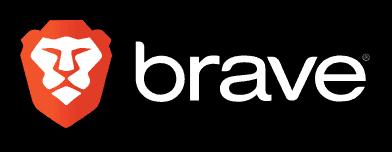Google Chrome Review
Google Chrome launched in 2008 and has become the industry standard. It’s changed a lot since, adding upgrades and features, as well as privacy concerns, which we’ll examine in detail.
The Google Chrome browser replaced older browsers like Internet Explorer and Mozilla Firefox as the industry standard in the early 2010s and now leads the way for web browsers. Google Chrome is fast, easy to use and in possession of the largest library of browser extensions. It is undoubtedly a solid browser for personal and professional use, as we’ll see in our Google Chrome review.
Key Takeaways:
- Google Chrome has a larger library of extensions than any other browser.
- Chrome is a fast and easy-to-use browser with a lot of useful tools, but Google has a reputation for using Chrome to invade its users’ privacy.
- Google Chrome offers some controls for opting out of data collection on the “my activity” page.
- Chrome is capable of making the same data available on your desktop and mobile device through device synchronization.
Google Chrome suffers from one fatal flaw, and it’s a flaw with all of Google’s services: its privacy practices — or the lack thereof. Google rakes in a huge profit from collecting the personal data of its users for the creation of personalized ads, so Google Chrome isn’t quite a “privacy-first” browser like some of its competitors.
Even if you’ve opted out of some data collection by adjusting your privacy settings, it’s worth noting that Google has violated its own privacy policy in the past, so there’s no telling how much you can trust Google’s privacy controls.
With that said, Google Chrome still performs excellently on most fronts and deserves its spot as the most popular web browser in the world. Let’s take a closer look at the ups and downs of this iconic browser in our Google Chrome review.
-
Completed a fresh review of Google Chrome, including performance, privacy and security; added an incognito section, a Google account section and a privacy sandbox section.
Google Chrome Review: Alternatives
Google Chrome: Strengths & Weaknesses
Pros:
- Easy to use
- Largest library of extensions
- Wide range of features
- Pretty fast
- Cross-device synchronization
Cons:
- Serious privacy concerns
Features
One of Google Chrome’s biggest assets in terms of features is its vast collection of browser extensions. No other browser rivals Google’s virtually limitless selection of extensions. That said, other browsers are catching up by using Google Chrome’s open-source code to make its extension library compatible with browsers like Brave, Microsoft Edge, Mozilla Firefox and others.
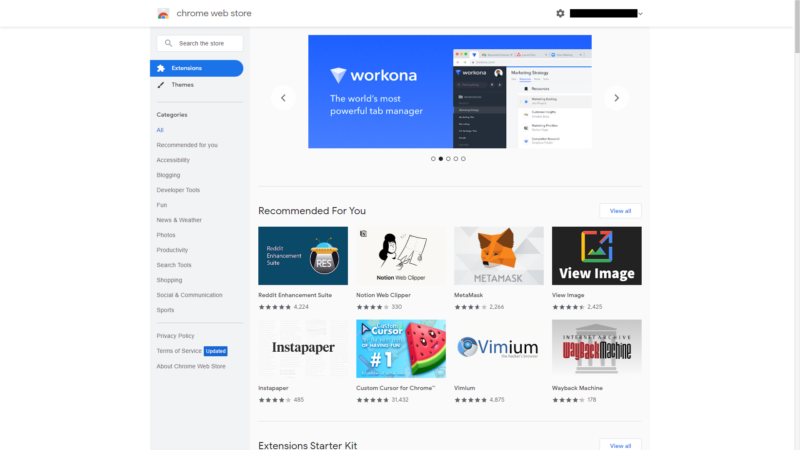
The Chrome Web Store is updated with hundreds of new extensions every day from thousands of developers, so no matter what obscure task you need to get done, there is probably an extension for it. Whether you want auto-refresh, safe browsing (and other browser security extensions), password managers or a better way to manage many tabs, there’s probably an extension for you.
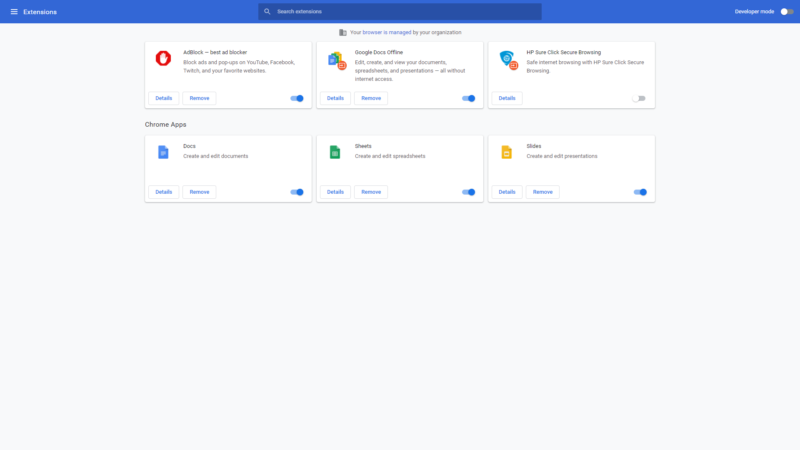
Even developers can benefit from Chrome’s endless selection of extensions.
These add-ons are designed to help developers create a better user experience online. From Window Resizer, which tests how a site displays on any screen size to the Lighthouse extension, which checks a website against essential web accessibility guidelines such as the ADA.
Device Sync
Google Chrome users can synchronize the data between the desktop and mobile versions of the browser with their Google account. Once you’ve signed in, the browser offers a selection of options for syncing types of data to other devices, such as your settings, browsing history, bookmarks, extensions, reading list, themes, saved passwords and more.
You can always backup Google Chrome to ensure that you’ll always have a copy of your favorite bookmarks, saved passwords, or browsing history. Othewise, if you are keen to have more space in your device, check out our guide on how to turn off sync on Google.
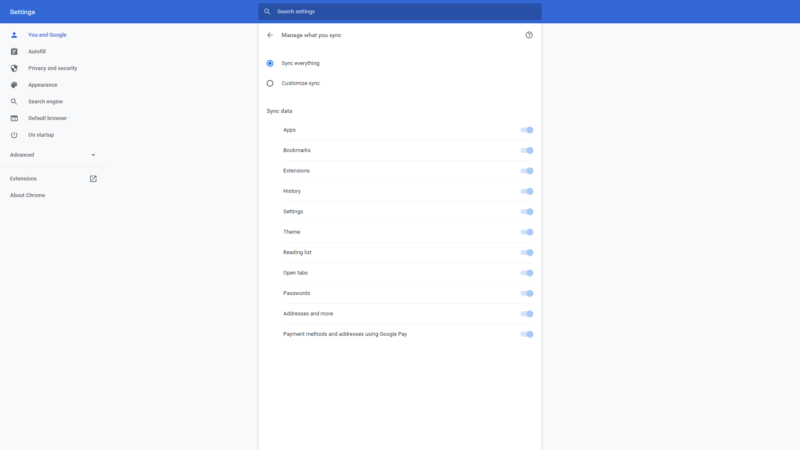
Managing Your Google Account
Your Google account is the seat of every Google service you use. Using any of Google’s services requires creating a Google account from which you can manage your data and settings for all your Google apps.
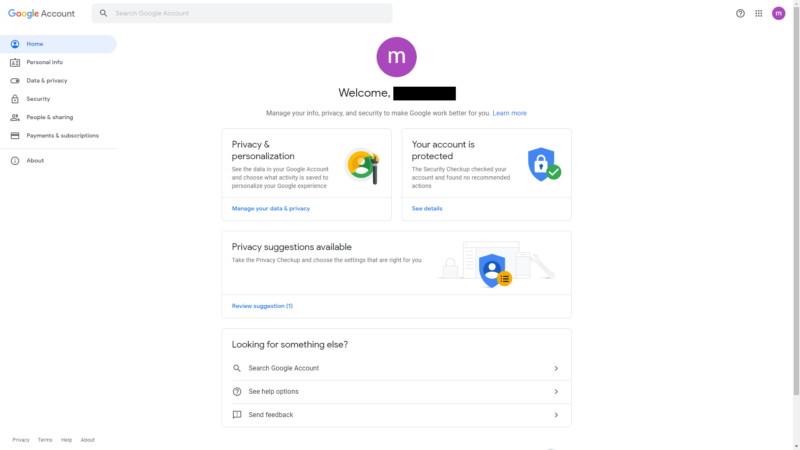
Whether you’re using Gmail, YouTube or Google Chrome, you’ll only need to sign in to a single account, unless you choose to create more than one account. Google provides the option to create personal and business accounts.
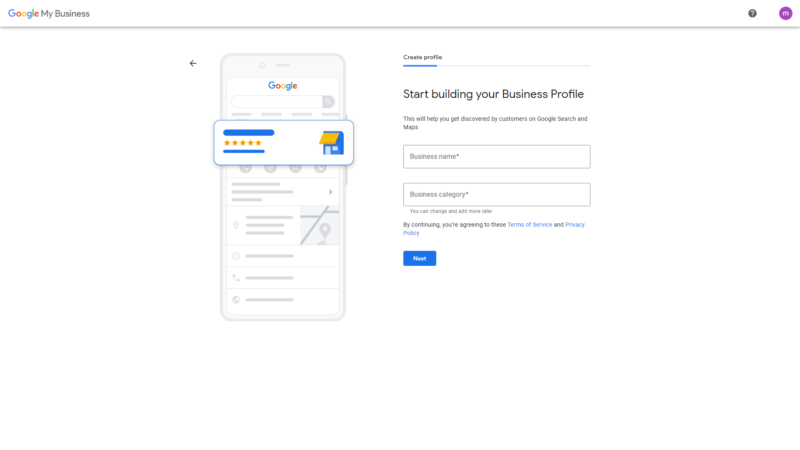
Signing in to Google Chrome with your Google account is a convenient way to keep your search history, bookmarks, settings and other synced data available, no matter the device. Whether you’re using your desktop, your phone or someone else’s internet-connected device, all your synced browser data can be accessed from anywhere.
Google Chrome can be used to browse the internet without signing in to the browser with your Google account, but signing in solves the privacy problems of shared computers. Multiple Google accounts can be added to a single device’s Chrome browser, so each user can access their synced browser data while keeping it separate from everyone else.
For business accounts, an admin account can be created using a non-Gmail company email address. The admin has the power to manage the settings and policies for multiple users at once, including each user’s Chrome settings.
Context Menu
Right-clicking within the browser opens up a context menu of features for quick access. In addition to standard browser features like copy-and-paste actions or opening links in new tabs, Google further integrates its search engine into Google Chrome with the “search Google for image” action. This was once only possible by downloading and uploading images into Google Images.
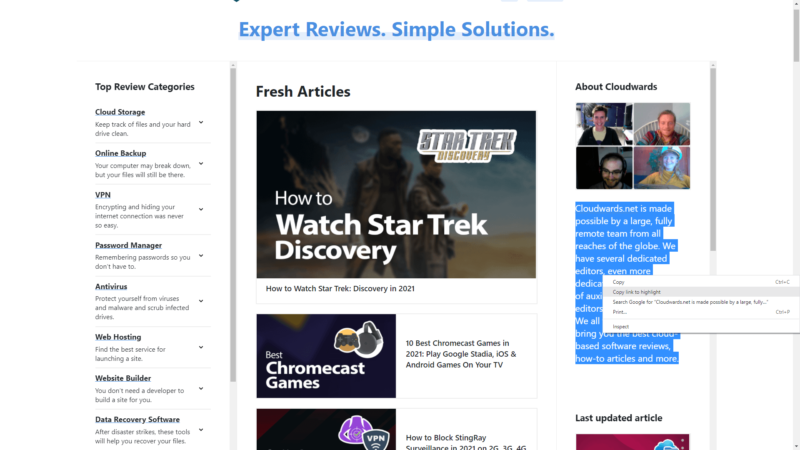
This is a welcome visual complement to the time-saving option to search Google for highlighted text through the context menu. The context menu also includes the option to create QR codes for images and pages on the internet without having to install third-party extensions.
Alongside the simple “copy” action is the relatively new feature “copy link to highlight,” which will create a link to a webpage with a highlight placed over the text you’ve selected. This is a useful feature for directing the recipients of your link to specific information on the page so they don’t have to scroll through the page to find it.
Reading List
Like any browser, Google Chrome has a simple Bookmarks feature, but it also includes a similar feature with a slightly different purpose. When bookmarking a page, you can add it to your “reading list” for offline viewing later in case you anticipate being on a plane, in a remote area or in some other setting where you won’t have internet access.
There are also bookmarking apps that can help you better organize all the web content you’d like to read offline such as Instapaper and Pocket.
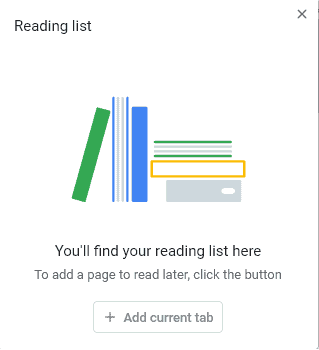
Adding a page to your bookmarks requires the internet to access the page. The “reading list” provides offline availability by downloading the page in advance. You can add web pages to your reading list from your computer and access them later from your phone (or vice versa) by syncing your devices. All documents will be displayed in Chrome’s built-in PDF reader, even when you’re offline.
Ease of Use
Part of what makes Google Chrome an easy browser to use is its simple user interface. In the desktop and mobile versions, the browser spares the user visual elements, despite coming with loads of features and extensions.
User Interface on Desktop
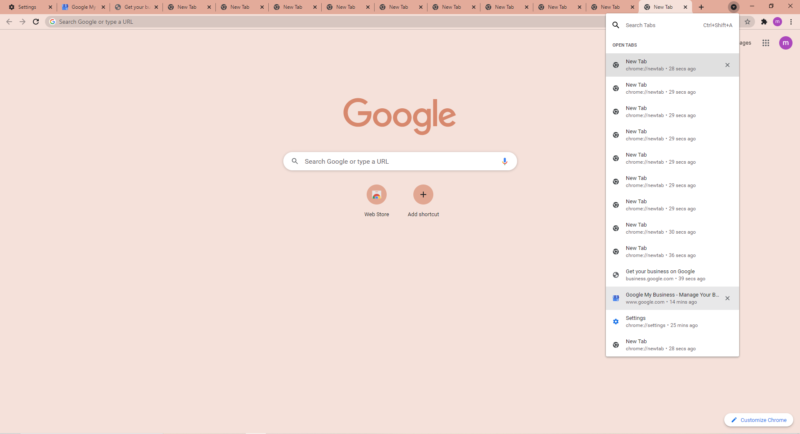
The browser window includes the address bar, navigation buttons, tabs at the top, a button for your extensions, a Google profile button, and a button that opens the Settings menu where most of its features are neatly tucked away. The address bar — or “omnibar” — returns Google Search results by default, but you can configure it to return the results of any search engine.
The desktop version of Google Chrome can pack a large number of tabs into the taskbar at once before they go off-screen. Most users should have more than enough space for their tabs, but less text is displayed in each tab as you add more tabs.
Fortunately, the “search tabs” button beside the minimize button will drop down a menu of all open tabs for easy navigation. Favicons remain displayed in each tab, even when the taskbar reaches its maximum capacity and no longer displays text.
Another way to keep your tabs organized is to assign tabs to groups. Right-click on any tab and click “add to new group” in the menu that appears. The next menu to appear will display a bar where you can type in the name of the tab group and assign a color to distinguish one group from the next. New tabs will not be added to a group until they are manually assigned one.
User Interface on Mobile
The mobile version of Google Chrome is simple and easy to use. The Android version is one of the best browsers for Android. It doesn’t vary much from its desktop counterpart, but one of its most notable features is the “request desktop site” button in the “settings” menu.
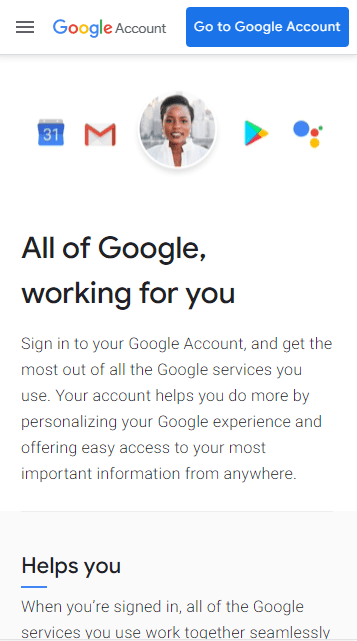
Some sites don’t have great mobile versions and are better viewed in the desktop version, especially when key elements are only on the desktop site.
Performance
We tested Chrome, Brave, Mozilla Firefox, Opera and Vivaldi using three benchmark tests, and Chrome came in first place in each one. Brave came close enough to Chrome’s speeds to be more or less identical in practice, while the rest fell further behind, though not by much. Check out our article on the six fastest web browsers for more information on browser speed.
| Benchmark Test: | Speedometer |
|---|---|
| Browser | Runs per Minute |
| Chrome | 121 |
| Brave | 102 |
| Mozilla Firefox | 95.5 |
| Opera | 116.6 |
| Vivaldi | 97.3 |
| Benchmark Test: | Jetstream |
|---|---|
| Browser | Score: |
| Chrome | 125.917 |
| Brave | 116.936 |
| Mozilla Firefox | 80.131 |
| Opera | 121.802 |
| Vivaldi | 116.540 |
| Benchmark Test: | Motion Mark |
|---|---|
| Browser | Score |
| Chrome | 496.32 |
| Brave | 444.67 |
| Mozilla Firefox | 145.93 |
| Opera | 373.27 |
| Vivaldi | 285.25 |
Chrome has acquired a reputation for being resource-hungry compared to most browsers, despite its fast speeds. The browser takes off at a brisk pace if you don’t have too many windows or tabs open, but giving Chrome more to do at the same time will cause it to devour your device’s RAM more rapidly than most of its competitors.
The good news is Google alleviated its RAM usage problem with an update in March 2021. Google released Chrome 89 with an advanced memory allocator known as “PartitionAlloc Fast Malloc” designed to stop any one process from consuming more than 10% of your device’s total memory.
The Chromium blog states this update saves up to 22% of system memory in the browser process. The blog goes on to say the update can save up to 100MiB per tab by discarding or reusing data the active tab isn’t using, like images that go off screen when scrolling past them or opening another tab.
Security
Chrome uses HTTPS by default and issues a warning before letting the user access a site only available in HTTP. Now that most of the internet uses HTTPS, that shouldn’t be a common problem, but Chrome has protections in place against unsecured and suspicious websites.
Using the HTTPS protocol by default also means Chrome operates faster than before, since it will connect to the website’s HTTPS endpoint instead of starting with HTTP and redirecting to HTTPS.
Ads & Pop-ups
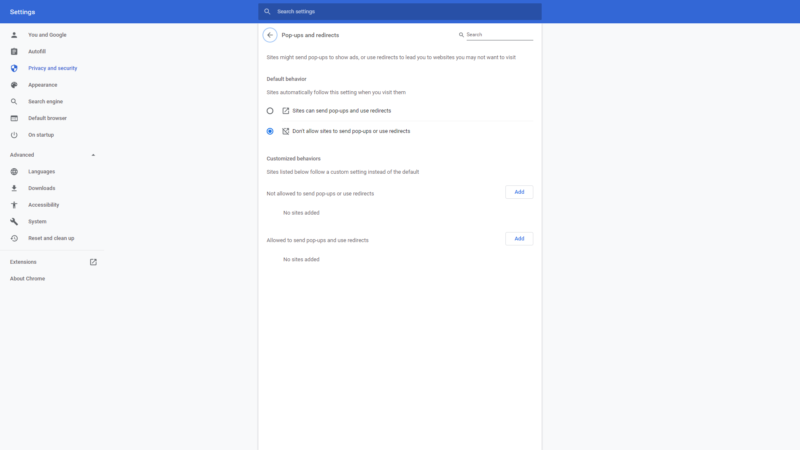
Chrome automatically blocks certain ads. It doesn’t block all ads by default since Google relies on advertising for its revenue, so the browser is designed only to block ads that fall short of the standards set by the Coalition for Better Ads, founded in part by Google itself.
Browsers designed for security, like Brave, automatically block all ads by default (read our Brave review). Fortunately for Chrome users, there are plenty of free ad blockers in Google’s library of extensions. We created an extensive guide on how to block ads on Chrome if you want to boost your protection against ads.
Pop-ups and redirects are blocked by default, but you can manually allow them if a trusted website’s functionality involves the use of pop-ups and redirects.
Credential Storage
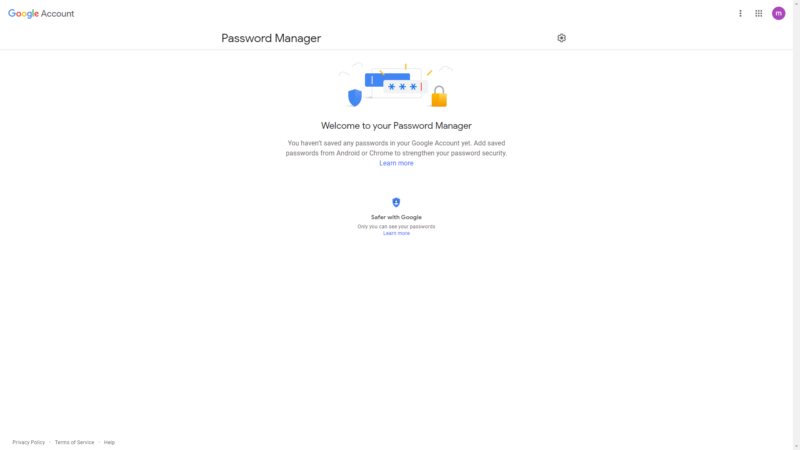
Chrome gives users the option to store their credentials in the browser to remain signed in to their favorite websites. The browser will ask if you want to save your password each time you sign in to a website or service, and you can view your saved passwords at passwords.google.com.
There are hundreds of password manager extensions compatible with Chrome, but we’ve picked out the best ones in our review of the five best password manager extensions.
Automatic Updates
Google quickly detects browser vulnerabilities and promptly issues patches in just days or even hours after discovery. Chrome automatically checks for updates and applies them every time you close and reopen the browser.
A notification informing you there are pending updates waiting to be installed will appear in your browser if it hasn’t been closed in a long time. This icon will turn from green to yellow to red as time goes on to indicate how outdated your browser is.
Privacy
Despite Google’s innovative products and services, the company is the biggest problem with Google Chrome. The browser may be secure against external cyberthreats — like malicious websites and malware — but Google has a spotty track record when it comes to handling its users’ private data.
The biggest portion of Google’s profit comes from ad revenue. Google collects your personal data and uses it to create ads tailored to your interests. It also uses the data to “personalize” the functionality of Google services according to your browsing patterns. One example of this is the auto-complete search results when you type into the search engine.
Google presents its data collection practices as a way to improve each user’s experience with Google services. If you find these features useful, by all means use them. It’s important to understand, though, that convenience and personalization comes at a cost.
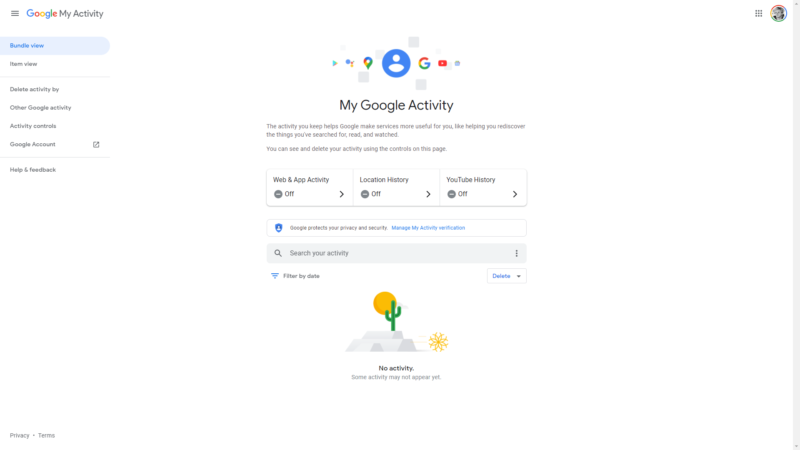
You can view the data Google collected on you by going to myactivity.google.com. The “my activity” web page classifies data into categories, such as your web and app activity, your location data, watched YouTube videos, and dozens of other types of data.
Each of these data categories is allowed to be collected by Google by default and that permission has to be manually deactivated if you want Google to stop collecting information about you. Even if you’ve disabled forms of data tracking in “my activity,” though, there’s no way to be certain if Google is turning against its own privacy policy or not.
Google has been found on many occasions to be tracking the location data of smartphone users even when the location history feature was turned off. Google also admitted to tracking its users’ purchases through their Gmail accounts without their knowledge or consent. This contradicts Google’s claim that no one at Google will be able to read any user’s emails.
If you want to go further than opt out of data collection on “my activity,” check out our top picks for the best privacy extensions.
Privacy Sandbox & the Federated Learning of Cohorts
Google rolled out a trial version of the Privacy Sandbox in Chrome in early 2021 as part of the company’s efforts to reform the online advertising industry. According to Google, the Privacy Sandbox will shift online advertising methods away from cross-site tracking mechanisms and third-party cookies to alternate methods that respect user privacy.
You will find the Privacy Sandbox in Chrome under Settings > Privacy and Security > Privacy Sandbox. It is enabled by default in select regions. The only two settings let you enable or disable the Privacy Sandbox trials and the alternative advertising method known as “FLoC,” or the Federated Learning of Cohorts.
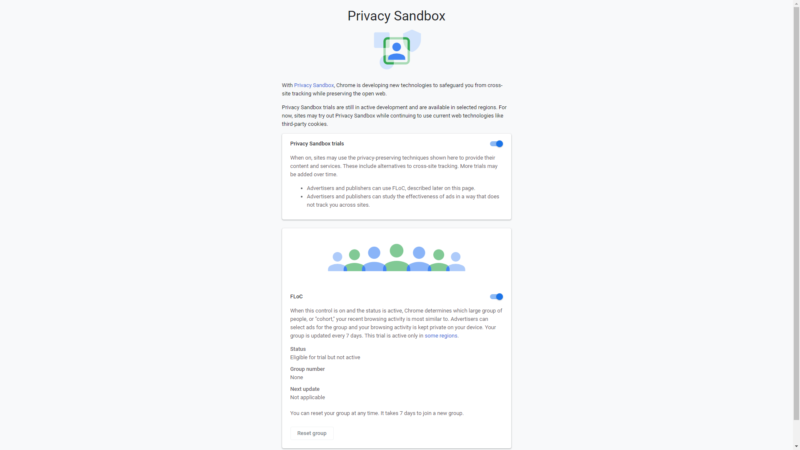
Tracking cookies allow advertising companies like Google to find out what each user’s preferences and interests are by collecting that user’s online activity. Advertising companies use cookies to identify individual users and create ads tailored to each user’s interest, as explained above.
This generates profit for companies like Google and keeps internet services in operation, but it compromises user privacy in the process. FLoC presents an alternative strategy.
With FLoC, Chrome will analyze user activity within the browser and place you in a group, or “cohort,” of those with similar browsing habits. The aggregate cohort datasets will be reported to websites that use FLoC, so your individual browsing data will not be distinguished from everyone else within your group.
That’s the theory, anyway. Not everyone is persuaded that Privacy Sandbox will do much to protect user privacy, but the feature is still undergoing development and will most likely be changed in substantial ways as time goes on.
Incognito Mode
Google Chrome is famous for innovating “Incognito Mode.” Going incognito in Chrome opens a separate window that doesn’t locally store history, cookies or site data, but you can still bookmark pages and download files.

Incognito Mode is commonly used to sign in to services from someone else’s device. Once you close your incognito tabs or windows, everything vanishes, so you won’t have to manually delete cookies, saved credentials or other data that could be abused by someone else using the device.
Browsing with an incognito window won’t shield your activity from your internet service provider, the websites you visit or, potentially, your school or employer. It’s a common misconception that this mode will make you anonymous online, but the function of Incognito Mode is much narrower than that.
For a completely anonymous browsing experience, we suggest using a VPN to hide your identity online instead. You can find out the best VPN for Chrome for that.
The Verdict
Google is without a doubt the industry standard for internet browsers and that doesn’t appear to be changing anytime soon. There’s little to complain about regarding the function of the browser, given Chrome’s wide array of tools and user-friendly interface. It’s loaded with useful tools on its own and can be augmented with its vast library of extensions.
Privacy is the main factor each prospective Chrome user should take into account before using this browser. Google’s data collection practices require users to make a tradeoff between privacy and ease of use when using Chrome, so your decision to use this browser will come down to what you value more.
If you value privacy above the many useful capabilities of Chrome, there are privacy-focused browsers based on Chrome’s source code and compatible with Chrome’s extension library that don’t collect as much personal data. We also have a guide on how to turn off Google AI.
Mozilla Firefox and Microsoft Edge are great options. You can check out how they fare against Chrome in our Chrome vs Firefox and Microsoft Edge vs Chrome comparison guides.
What do you think about Google Chrome? Is it still the best browser or do you think some of its competitors are catching up? Is privacy your top value or would you rather have a simple-to-use and feature-rich browser? Let us know in the comments below, and as always, thanks for reading.
FAQ
Google Chrome is a great browser for everyday use as far as the browser’s capabilities are concerned. However, Google’s data collection practices make Chrome one of the worst browsers for privacy, and we recommend using a more privacy-conscious browser.
The biggest reason to opt for another browser is to avoid Google harvesting your personal data. Google makes most of its money by collecting the data of its users and using it for targeted advertising, so Chrome won’t do much to protect your privacy.
Chrome is secure from external threats like malicious websites, malware and hackers, but its privacy controls won’t stop Google from collecting at least some of your personal information.

